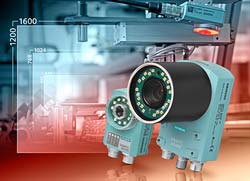Siemens expands optical code reading systems with new functions and additional variants

Siemens Division Industry Automation is expanding its portfolio for industrial identification with a new “Ultra High Resolution” variant of the Simatic MV440 reader with a resolution of 1600 x 1200 pixels. Also, all the MV440 models have new functions, such as Power over Ethernet (PoE). Further innovations, such as Profinet IO device replacement, have even been applied to the smaller Simatic MV420 model.
The “Ultra High Resolution” variant with a resolution of 1600 x 1200 pixels is new to the Siemens family of Simatic MV440 code reading systems. Previously devices were available with resolutions of 640 x 480 or 1024 x 768 pixels. The higher resolution gives the Ultra High Resolution variant a particularly wide field of view, whereby up to 150 individual, or particularly large, codes can be read simultaneously. With the OCR license (Optical Character Recognition) “Text Genius” customers can expand the functional scope, also of the new device, with text recognition.
Furthermore, Siemens has added PoE throughout the Simatic MV440 product group. This means that power, picture data and even time-critical data can be transmitted over a shared cable, which reduces the cabling outlay considerably. With the Industrial Ethernet Switches Scalance X108 PoE/X308-2M and PoE/XR324-4M PoE, Siemens is also offering the corresponding network components for drawing power from the Ethernet cable.
Under the new firmware version 4.0 upwards, users can retrofit all Simatic MV440 variants with the verification function for checking the marking quality of the code with a separate license “Veri-Genius”. This can be downloaded through the Simatic Automation License Manager to every MV440 device that is equipped with the new firmware. The latest firmware version also covers the most recent AIM specification AIM-DPM-1-2006.
A further innovation that concerns all variants of the Simatic MV440 and MV420 code readers is Profinet IO device replacement. This reduces the configuration work to a minimum following replacement of a defective device, resulting in lower maintenance costs and minimal downtime for the plant. It is also possible for the Simatic MV440 and MV420 SR-P code readers to automatically detect the number of codes and their types immediately, which means that dynamic code types can be used.
As a consequence of their new functions, the Simatic MV440 and MV420 code readers are opening up new application areas. These include scanner applications such as reading codes from packaging units that are being rotated by a robot in front of the reader. Further examples are gate applications in master/slave mode in which the master code reading system rejects codes that have been read multiple times by the slaves, which results in faster processing of the scanned data.
Under the name of Simatic Ident, Siemens Division Industry Automation offers a comprehensive product portfolio for industrial identification. The Simatic Ident offering comprises RFID systems as well as optical code reading systems. The stationary 1D/2D code reading systems, Simatic MV420 and Simatic MV440, are characterized by their high-speed and reliable reading performance – even under severe environmental conditions in industrial use. They read easy, high-contrast codes as well as the difficult-to-read DPM codes (Direct Part Marking) on the product itself. With versatile lighting options, a wide selection of communication and connection possibilities, and their compact size, the Siemens code readers are suitable for a wide range of industrial applications. Simatic MV420 and Simatic MV440 are used by companies operating in different sectors, such as the automobile, packaging, pharmaceuticals, tobacco, cosmetics and electronics industries, as well as in applications in the food and beverages sector.
The Siemens Industry Sector (Erlangen, Germany) is the worldwide leading supplier of environmentally friendly production, transportation, building and lighting technologies. With integrated automation technologies and comprehensive industry-specific solutions, Siemens increases the productivity, efficiency and flexibility of its customers in the fields of industry and infrastructure. The Sector consists of six divisions: Building Technologies, Drive Technologies, Industry Automation, Industry Solutions, Mobility and Osram. With around 204,000 employees worldwide (September 30), Siemens Industry achieved in fiscal year 2010 total sales of approximately €34.9 billion. http://www.siemens.com/industry
The Siemens Industry Automation Division (Nuremberg, Germany) is a worldwide leader in the fields of automation systems, industrial controls and industrial software. Its portfolio ranges from standard products for the manufacturing and process industries to solutions for whole industrial sectors that encompass the automation of entire automobile production facilities and chemical plants. As a leading software supplier, Industry Automation optimizes the entire value added chain of manufacturers – from product design and development to production, sales and a wide range of maintenance services. With around 33,000 employees worldwide (September 30), Siemens Industry Automation achieved sales of €6.2 billion in fiscal year 2010. http://www.siemens.com/industryautomation
Reference Number: IIA2011032618e
Media Contact
More Information:
http://www.siemens.com/identAll latest news from the category: Machine Engineering
Machine engineering is one of Germany’s key industries. The importance of this segment has led to the creation of new university degree programs in fields such as production and logistics, process engineering, vehicle/automotive engineering, production engineering and aerospace engineering among others.
innovations-report offers informative reports and articles covering technologies such as automation, motion, power train, energy, conveyor, plastics, lightweight construction, logistics/warehousing, measurement systems, machine tools and control engineering.
Newest articles

Innovative 3D printed scaffolds offer new hope for bone healing
Researchers at the Institute for Bioengineering of Catalonia have developed novel 3D printed PLA-CaP scaffolds that promote blood vessel formation, ensuring better healing and regeneration of bone tissue. Bone is…

The surprising role of gut infection in Alzheimer’s disease
ASU- and Banner Alzheimer’s Institute-led study implicates link between a common virus and the disease, which travels from the gut to the brain and may be a target for antiviral…

Molecular gardening: New enzymes discovered for protein modification pruning
How deubiquitinases USP53 and USP54 cleave long polyubiquitin chains and how the former is linked to liver disease in children. Deubiquitinases (DUBs) are enzymes used by cells to trim protein…



